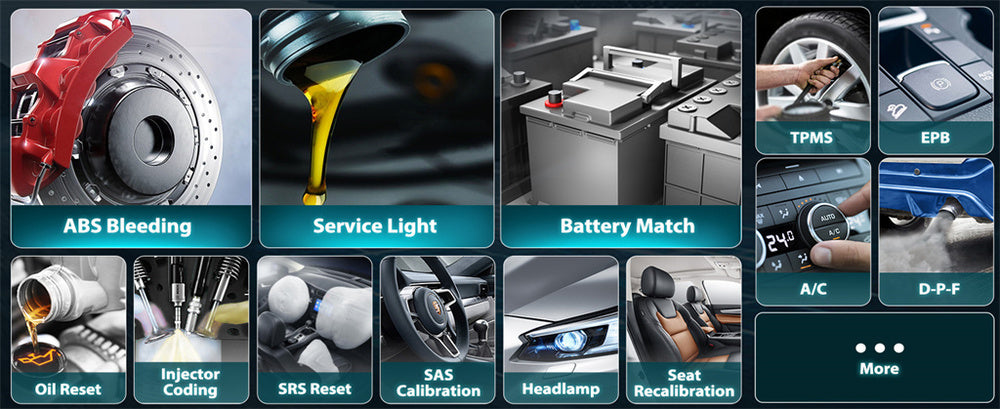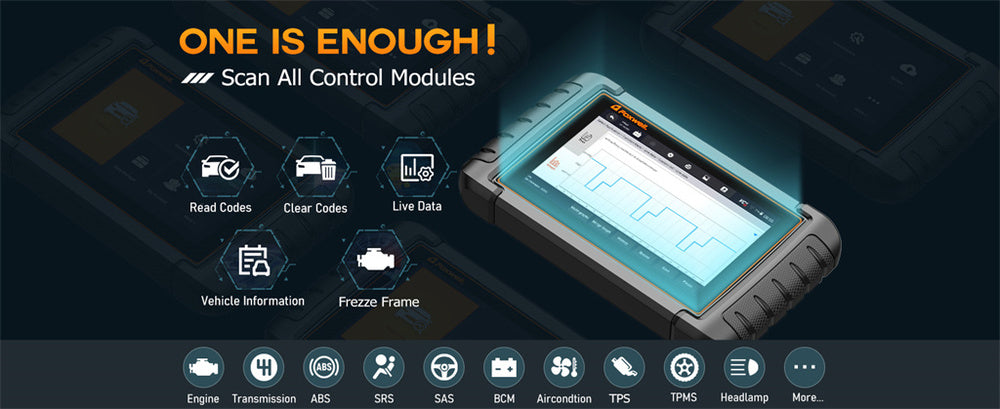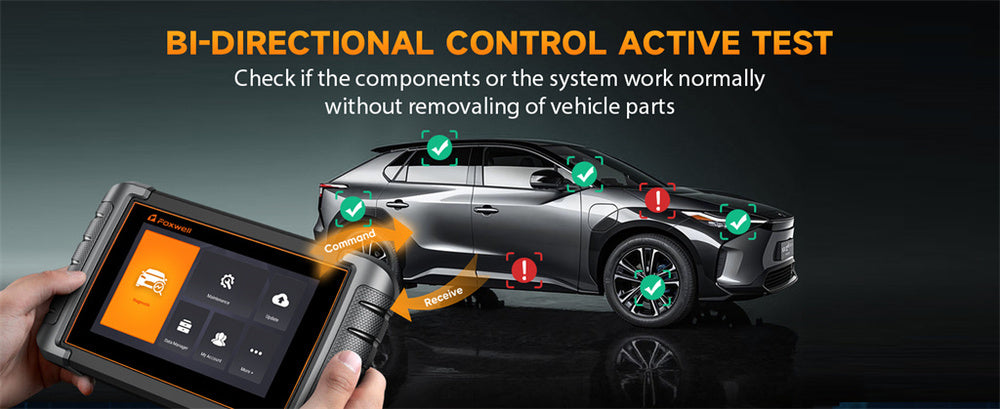Yes, an advanced OBD2 scanner can diagnose most electrical issues in a vehicle and, in many cases, detect if a fuse is blown. While the scanner won't physically inspect the fuse, it can identify circuit-related problems that indicate a blown fuse.
Modern scanners, like the Foxwell NT809BT, go beyond basic engine diagnostics by offering real-time data, multi-system checks, and advanced features that help pinpoint electrical faults, making it an invaluable tool for maintaining your car's electrical health.
How to Use an OBD2 Scanner to Detect Electrical Issues

Using an OBD2 scanner is easier than finding a parking spot in a crowded lot—trust me! First, connect the scanner to your vehicle's OBD2 port, usually found under the dashboard.
Once powered up, it communicates with the vehicle’s computer systems. Select the option to read diagnostic trouble codes (DTCs). These codes are like secret messages that tell you what’s wrong.
But here’s the kicker: don’t just stop at the codes! Dig deeper by accessing live data from various sensors. This real-time information allows you to see how your vehicle's systems are behaving under different conditions.
If you encounter an issue, note the specific DTC and research the corresponding solution—whether it’s replacing a faulty sensor, repairing damaged wiring, or resetting the system after fixing an issue.
Detailed Functionality of OBD2 Scanners for Checking Fuses
Now, let's talk about one of the most underrated features of OBD2 scanners: fuse checking. While it won’t physically inspect the fuse, it can detect electrical issues caused by blown fuses through error codes related to specific circuits.
For instance, if a fuse connected to the headlights is blown, the scanner will throw a DTC indicating a malfunction in that circuit. After identifying the problem, you can check the fuse box to replace the blown fuse, ensuring that the new fuse is of the correct amperage.
Additionally, if a fuse repeatedly blows, investigate the underlying cause, such as a short circuit or a malfunctioning component, to prevent future occurrences.
Common Electrical Issues and Their Diagnostic Methods
Electrical problems can be the nemeses of car owners, often manifesting in unpredictable ways. Some common issues include faulty sensors, bad wiring, and dead batteries. A reliable OBD2 scanner can help diagnose these problems effectively.
For example, if your check engine light pops on, it could be due to a malfunctioning oxygen sensor. By reading the DTC, you can identify the specific sensor at fault, allowing you to address the issue without guessing. Remember, guessing is for games, not for fixing your car!
Tips and Best Practices for Using OBD2 Scanners
To get the most out of your OBD2 scanner, especially if you're using the Foxwell NT809BT, here are some tips tailored for this specific model:
Leverage Bluetooth Connectivity: The Foxwell NT809BT features Bluetooth connectivity, allowing you to connect it to your smartphone or tablet. This makes it easy to access live data and diagnostics from a distance, so you can keep an eye on your vehicle while doing other tasks.
Utilize the Enhanced Features: This scanner offers advanced diagnostic functions, including the ability to read and clear codes from all systems, not just the engine. Take advantage of this feature to get a comprehensive view of your vehicle's health, from transmission issues to airbag malfunctions.
Stay Updated: Regularly check for software updates. The Foxwell NT809BT can be updated via the internet, ensuring that you always have the latest features and support for new vehicles. Keeping it current can enhance its performance and diagnostic accuracy.
Explore Live Data Graphing: Use the live data graphing feature to visualize sensor readings in real-time. This can help you identify intermittent issues that may not trigger a code but could affect your vehicle's performance.
Refer to the User Manual: Don’t underestimate the power of the user manual. It contains valuable information about specific functions and troubleshooting tips for the Foxwell NT809BT, making it a handy reference during diagnostics.
Join Online Communities: Consider joining forums or social media groups dedicated to automotive diagnostics. Engaging with other Foxwell NT809BT users can provide you with additional insights, tips, and troubleshooting advice based on shared experiences.

Choosing the Right OBD2 Scanner: Features and Performance Comparison
Not all OBD2 scanners are created equal, and choosing the right one can make all the difference. When evaluating different models, consider the following features:
Compatibility: Ensure the scanner supports your vehicle's make and model, as some models may not be compatible with certain brands or newer vehicles.
Diagnostic Functions: Look for scanners that offer comprehensive diagnostic capabilities, including access to all systems (engine, transmission, ABS, airbags, etc.), rather than just basic engine diagnostics.
User Interface: A clear, intuitive interface can make a significant difference in your experience. Touchscreen models often provide easier navigation compared to button-operated ones.
Data Recording and Playback: Some scanners allow you to record live data and play it back later, which can be helpful for diagnosing intermittent issues.
Bluetooth and App Integration: Scanners like the Foxwell NT809BT offer Bluetooth connectivity, which allows you to connect to mobile apps for enhanced functionality, including updates and additional diagnostic tools.
Price and Warranty: Compare prices among different models while considering the warranty offered. A longer warranty can be a sign of a manufacturer’s confidence in their product.
By considering these factors, you can choose an OBD2 scanner that meets your needs and helps you diagnose and resolve electrical issues efficiently.
Conclusion
In conclusion, OBD2 scanners are indispensable tools for anyone serious about vehicle maintenance. They not only diagnose electrical faults but also empower you with knowledge, turning you from a mere driver into an informed vehicle owner.
So next time your car throws a tantrum, don’t panic—grab your scanner and become the hero of your own automotive saga!
By understanding the capabilities of OBD2 scanners and how to use them effectively, you can tackle electrical issues with confidence and keep your vehicle running smoothly.
FAQs
How do you find out what causes a blown fuse in a car?
A blown fuse is usually caused by an electrical overload or short circuit. You can identify the underlying issue by using an OBD2 scanner to detect any related trouble codes and inspecting the circuits or components tied to the affected fuse.
How can you test to see if a fuse was blown?
You can visually inspect the fuse to see if the metal filament inside is broken. Alternatively, use a multimeter to check for continuity or an OBD2 scanner that reads circuit-related error codes.
What is the best professional OBD2 scanner?
The Foxwell NT809BT is a top choice for professionals. It offers full-system diagnostics, Bluetooth connectivity, live data graphing, and regular software updates, making it ideal for comprehensive vehicle diagnostics.




Leave a comment
This site is protected by hCaptcha and the hCaptcha Privacy Policy and Terms of Service apply.